Comprehensive Sales Plan: Objectives, Strategies, and Action Plan
VerifiedAdded on 2023/04/20
|49
|11258
|311
Project
AI Summary
This project provides a detailed sales plan, starting with formative assessments covering company profiles, target markets, and sales performance reviews. It explores market-based information, segmentation, and the importance of quantifiable data for assumptions and sales forecasting. The plan emphasizes setting achievable sales targets and monitoring effectiveness, aligning sales goals with operational objectives. Various sales approaches are discussed, along with appropriate strategies for different products and services. The summative assessments include organizational context, background to the sales plan, sales objectives and targets, and a sales plan action plan, covering approaches to meet sales objectives, human and non-human resource requirements, budget allocations, potential risks and controls, advertising and promotional strategies, and distribution channels. The document concludes with references, providing a holistic view of developing and implementing a successful sales plan.

Running head: DEVELOP A SALES PLAN
Develop a Sales Plan
Name of the student:
Name of the university:
Author note:
Develop a Sales Plan
Name of the student:
Name of the university:
Author note:
Paraphrase This Document
Need a fresh take? Get an instant paraphrase of this document with our AI Paraphraser
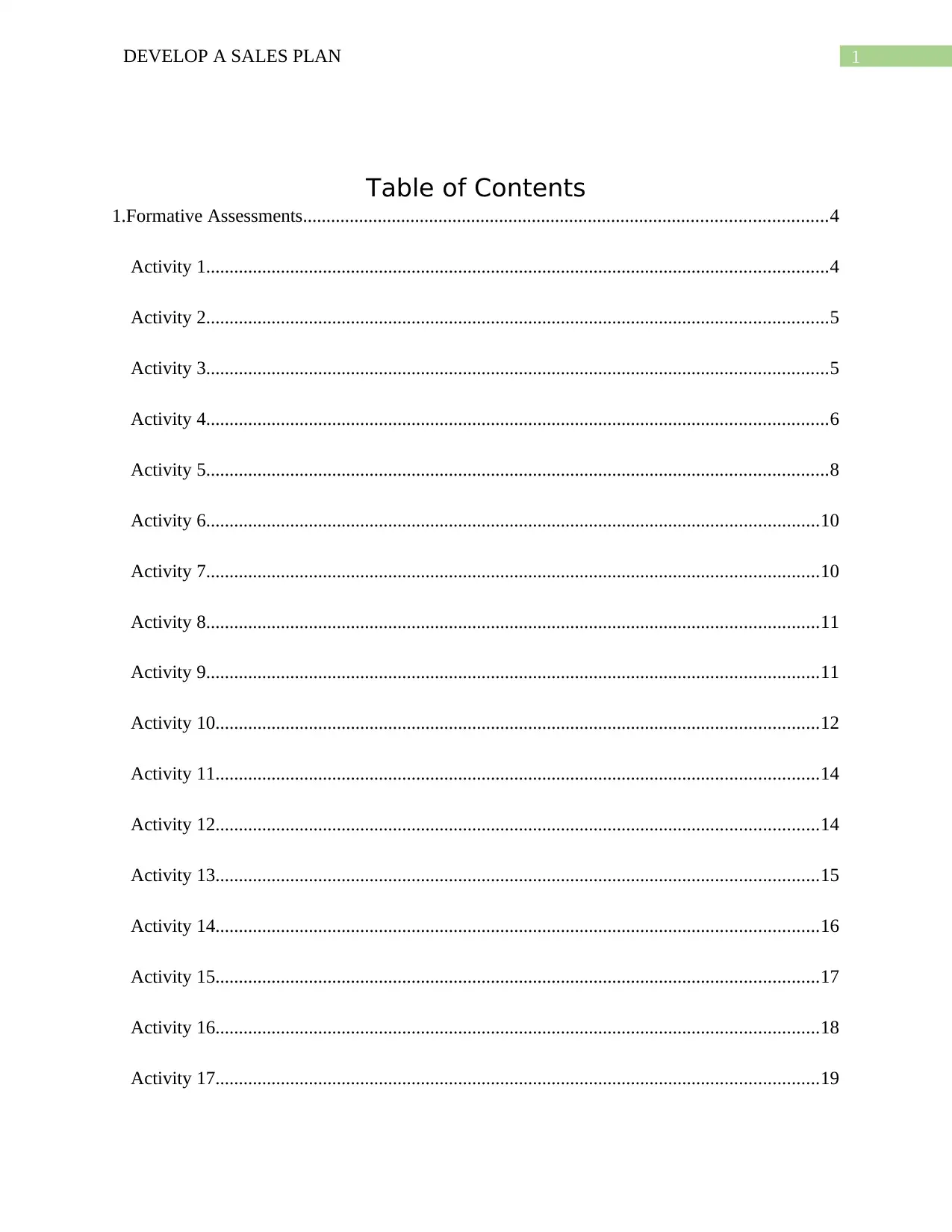
1DEVELOP A SALES PLAN
Table of Contents
1.Formative Assessments................................................................................................................4
Activity 1.....................................................................................................................................4
Activity 2.....................................................................................................................................5
Activity 3.....................................................................................................................................5
Activity 4.....................................................................................................................................6
Activity 5.....................................................................................................................................8
Activity 6...................................................................................................................................10
Activity 7...................................................................................................................................10
Activity 8...................................................................................................................................11
Activity 9...................................................................................................................................11
Activity 10.................................................................................................................................12
Activity 11.................................................................................................................................14
Activity 12.................................................................................................................................14
Activity 13.................................................................................................................................15
Activity 14.................................................................................................................................16
Activity 15.................................................................................................................................17
Activity 16.................................................................................................................................18
Activity 17.................................................................................................................................19
Table of Contents
1.Formative Assessments................................................................................................................4
Activity 1.....................................................................................................................................4
Activity 2.....................................................................................................................................5
Activity 3.....................................................................................................................................5
Activity 4.....................................................................................................................................6
Activity 5.....................................................................................................................................8
Activity 6...................................................................................................................................10
Activity 7...................................................................................................................................10
Activity 8...................................................................................................................................11
Activity 9...................................................................................................................................11
Activity 10.................................................................................................................................12
Activity 11.................................................................................................................................14
Activity 12.................................................................................................................................14
Activity 13.................................................................................................................................15
Activity 14.................................................................................................................................16
Activity 15.................................................................................................................................17
Activity 16.................................................................................................................................18
Activity 17.................................................................................................................................19
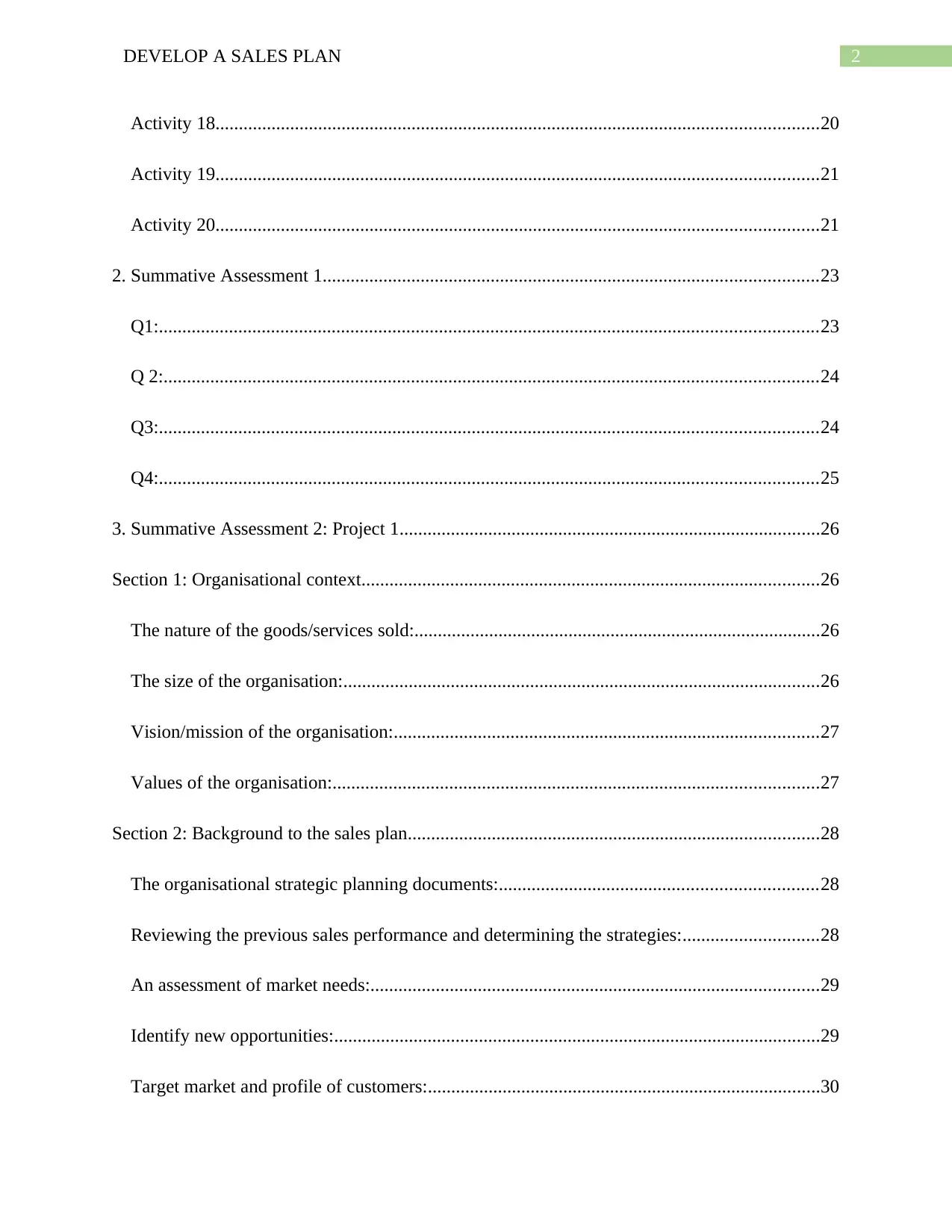
2DEVELOP A SALES PLAN
Activity 18.................................................................................................................................20
Activity 19.................................................................................................................................21
Activity 20.................................................................................................................................21
2. Summative Assessment 1..........................................................................................................23
Q1:.............................................................................................................................................23
Q 2:............................................................................................................................................24
Q3:.............................................................................................................................................24
Q4:.............................................................................................................................................25
3. Summative Assessment 2: Project 1..........................................................................................26
Section 1: Organisational context..................................................................................................26
The nature of the goods/services sold:.......................................................................................26
The size of the organisation:......................................................................................................26
Vision/mission of the organisation:...........................................................................................27
Values of the organisation:........................................................................................................27
Section 2: Background to the sales plan........................................................................................28
The organisational strategic planning documents:....................................................................28
Reviewing the previous sales performance and determining the strategies:.............................28
An assessment of market needs:................................................................................................29
Identify new opportunities:........................................................................................................29
Target market and profile of customers:....................................................................................30
Activity 18.................................................................................................................................20
Activity 19.................................................................................................................................21
Activity 20.................................................................................................................................21
2. Summative Assessment 1..........................................................................................................23
Q1:.............................................................................................................................................23
Q 2:............................................................................................................................................24
Q3:.............................................................................................................................................24
Q4:.............................................................................................................................................25
3. Summative Assessment 2: Project 1..........................................................................................26
Section 1: Organisational context..................................................................................................26
The nature of the goods/services sold:.......................................................................................26
The size of the organisation:......................................................................................................26
Vision/mission of the organisation:...........................................................................................27
Values of the organisation:........................................................................................................27
Section 2: Background to the sales plan........................................................................................28
The organisational strategic planning documents:....................................................................28
Reviewing the previous sales performance and determining the strategies:.............................28
An assessment of market needs:................................................................................................29
Identify new opportunities:........................................................................................................29
Target market and profile of customers:....................................................................................30
⊘ This is a preview!⊘
Do you want full access?
Subscribe today to unlock all pages.

Trusted by 1+ million students worldwide
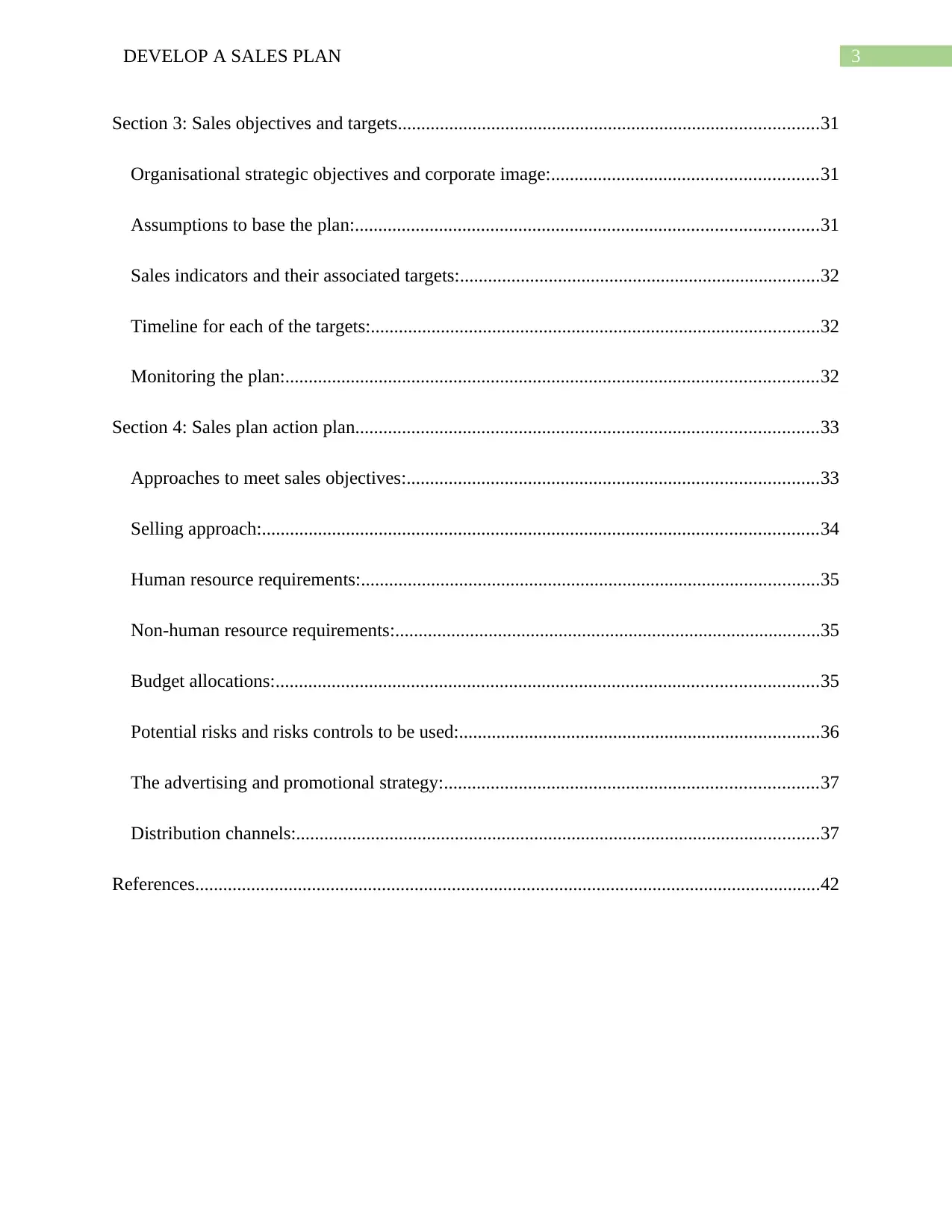
3DEVELOP A SALES PLAN
Section 3: Sales objectives and targets..........................................................................................31
Organisational strategic objectives and corporate image:.........................................................31
Assumptions to base the plan:...................................................................................................31
Sales indicators and their associated targets:.............................................................................32
Timeline for each of the targets:................................................................................................32
Monitoring the plan:..................................................................................................................32
Section 4: Sales plan action plan...................................................................................................33
Approaches to meet sales objectives:........................................................................................33
Selling approach:.......................................................................................................................34
Human resource requirements:..................................................................................................35
Non-human resource requirements:...........................................................................................35
Budget allocations:....................................................................................................................35
Potential risks and risks controls to be used:.............................................................................36
The advertising and promotional strategy:................................................................................37
Distribution channels:................................................................................................................37
References......................................................................................................................................42
Section 3: Sales objectives and targets..........................................................................................31
Organisational strategic objectives and corporate image:.........................................................31
Assumptions to base the plan:...................................................................................................31
Sales indicators and their associated targets:.............................................................................32
Timeline for each of the targets:................................................................................................32
Monitoring the plan:..................................................................................................................32
Section 4: Sales plan action plan...................................................................................................33
Approaches to meet sales objectives:........................................................................................33
Selling approach:.......................................................................................................................34
Human resource requirements:..................................................................................................35
Non-human resource requirements:...........................................................................................35
Budget allocations:....................................................................................................................35
Potential risks and risks controls to be used:.............................................................................36
The advertising and promotional strategy:................................................................................37
Distribution channels:................................................................................................................37
References......................................................................................................................................42
Paraphrase This Document
Need a fresh take? Get an instant paraphrase of this document with our AI Paraphraser
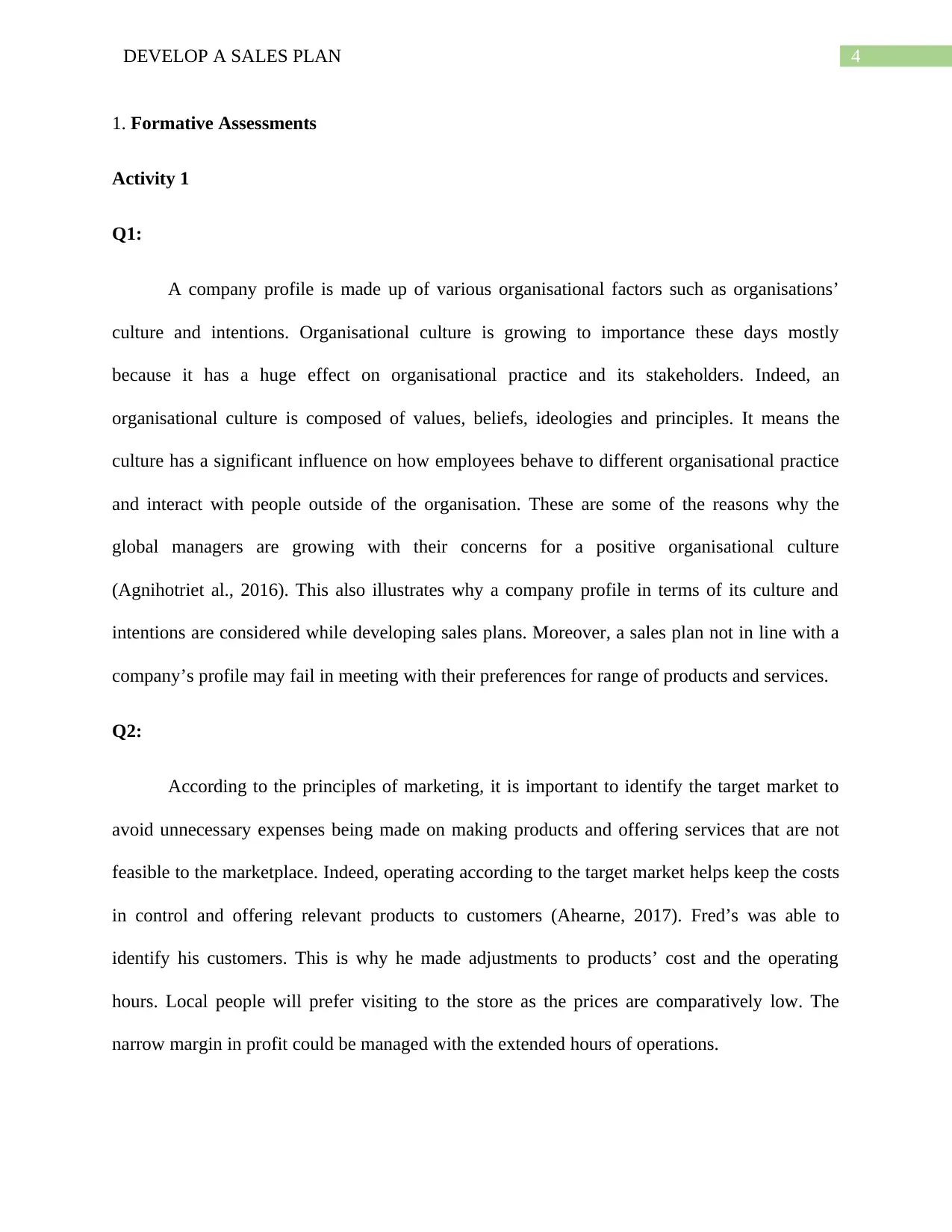
4DEVELOP A SALES PLAN
1. Formative Assessments
Activity 1
Q1:
A company profile is made up of various organisational factors such as organisations’
culture and intentions. Organisational culture is growing to importance these days mostly
because it has a huge effect on organisational practice and its stakeholders. Indeed, an
organisational culture is composed of values, beliefs, ideologies and principles. It means the
culture has a significant influence on how employees behave to different organisational practice
and interact with people outside of the organisation. These are some of the reasons why the
global managers are growing with their concerns for a positive organisational culture
(Agnihotriet al., 2016). This also illustrates why a company profile in terms of its culture and
intentions are considered while developing sales plans. Moreover, a sales plan not in line with a
company’s profile may fail in meeting with their preferences for range of products and services.
Q2:
According to the principles of marketing, it is important to identify the target market to
avoid unnecessary expenses being made on making products and offering services that are not
feasible to the marketplace. Indeed, operating according to the target market helps keep the costs
in control and offering relevant products to customers (Ahearne, 2017). Fred’s was able to
identify his customers. This is why he made adjustments to products’ cost and the operating
hours. Local people will prefer visiting to the store as the prices are comparatively low. The
narrow margin in profit could be managed with the extended hours of operations.
1. Formative Assessments
Activity 1
Q1:
A company profile is made up of various organisational factors such as organisations’
culture and intentions. Organisational culture is growing to importance these days mostly
because it has a huge effect on organisational practice and its stakeholders. Indeed, an
organisational culture is composed of values, beliefs, ideologies and principles. It means the
culture has a significant influence on how employees behave to different organisational practice
and interact with people outside of the organisation. These are some of the reasons why the
global managers are growing with their concerns for a positive organisational culture
(Agnihotriet al., 2016). This also illustrates why a company profile in terms of its culture and
intentions are considered while developing sales plans. Moreover, a sales plan not in line with a
company’s profile may fail in meeting with their preferences for range of products and services.
Q2:
According to the principles of marketing, it is important to identify the target market to
avoid unnecessary expenses being made on making products and offering services that are not
feasible to the marketplace. Indeed, operating according to the target market helps keep the costs
in control and offering relevant products to customers (Ahearne, 2017). Fred’s was able to
identify his customers. This is why he made adjustments to products’ cost and the operating
hours. Local people will prefer visiting to the store as the prices are comparatively low. The
narrow margin in profit could be managed with the extended hours of operations.
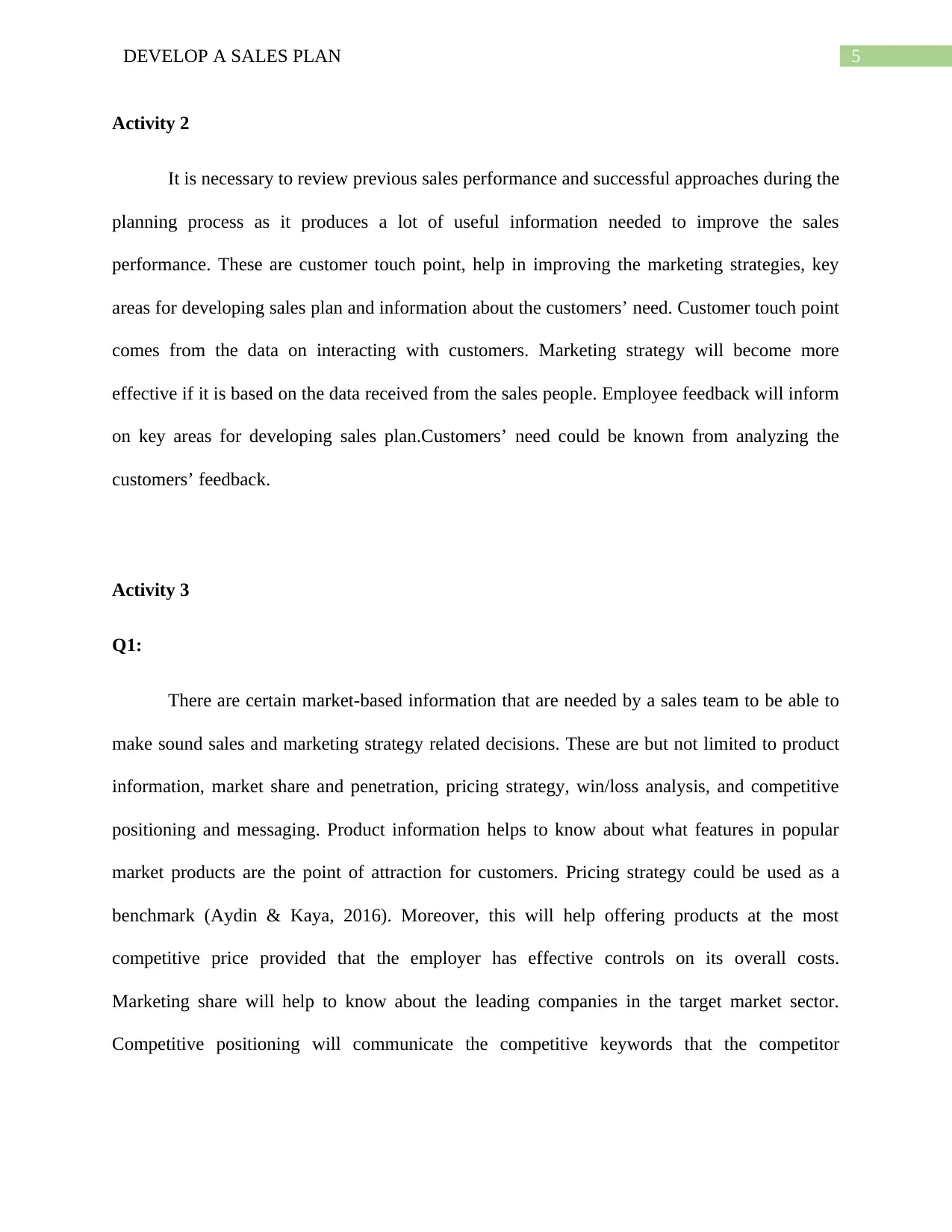
5DEVELOP A SALES PLAN
Activity 2
It is necessary to review previous sales performance and successful approaches during the
planning process as it produces a lot of useful information needed to improve the sales
performance. These are customer touch point, help in improving the marketing strategies, key
areas for developing sales plan and information about the customers’ need. Customer touch point
comes from the data on interacting with customers. Marketing strategy will become more
effective if it is based on the data received from the sales people. Employee feedback will inform
on key areas for developing sales plan.Customers’ need could be known from analyzing the
customers’ feedback.
Activity 3
Q1:
There are certain market-based information that are needed by a sales team to be able to
make sound sales and marketing strategy related decisions. These are but not limited to product
information, market share and penetration, pricing strategy, win/loss analysis, and competitive
positioning and messaging. Product information helps to know about what features in popular
market products are the point of attraction for customers. Pricing strategy could be used as a
benchmark (Aydin & Kaya, 2016). Moreover, this will help offering products at the most
competitive price provided that the employer has effective controls on its overall costs.
Marketing share will help to know about the leading companies in the target market sector.
Competitive positioning will communicate the competitive keywords that the competitor
Activity 2
It is necessary to review previous sales performance and successful approaches during the
planning process as it produces a lot of useful information needed to improve the sales
performance. These are customer touch point, help in improving the marketing strategies, key
areas for developing sales plan and information about the customers’ need. Customer touch point
comes from the data on interacting with customers. Marketing strategy will become more
effective if it is based on the data received from the sales people. Employee feedback will inform
on key areas for developing sales plan.Customers’ need could be known from analyzing the
customers’ feedback.
Activity 3
Q1:
There are certain market-based information that are needed by a sales team to be able to
make sound sales and marketing strategy related decisions. These are but not limited to product
information, market share and penetration, pricing strategy, win/loss analysis, and competitive
positioning and messaging. Product information helps to know about what features in popular
market products are the point of attraction for customers. Pricing strategy could be used as a
benchmark (Aydin & Kaya, 2016). Moreover, this will help offering products at the most
competitive price provided that the employer has effective controls on its overall costs.
Marketing share will help to know about the leading companies in the target market sector.
Competitive positioning will communicate the competitive keywords that the competitor
⊘ This is a preview!⊘
Do you want full access?
Subscribe today to unlock all pages.

Trusted by 1+ million students worldwide
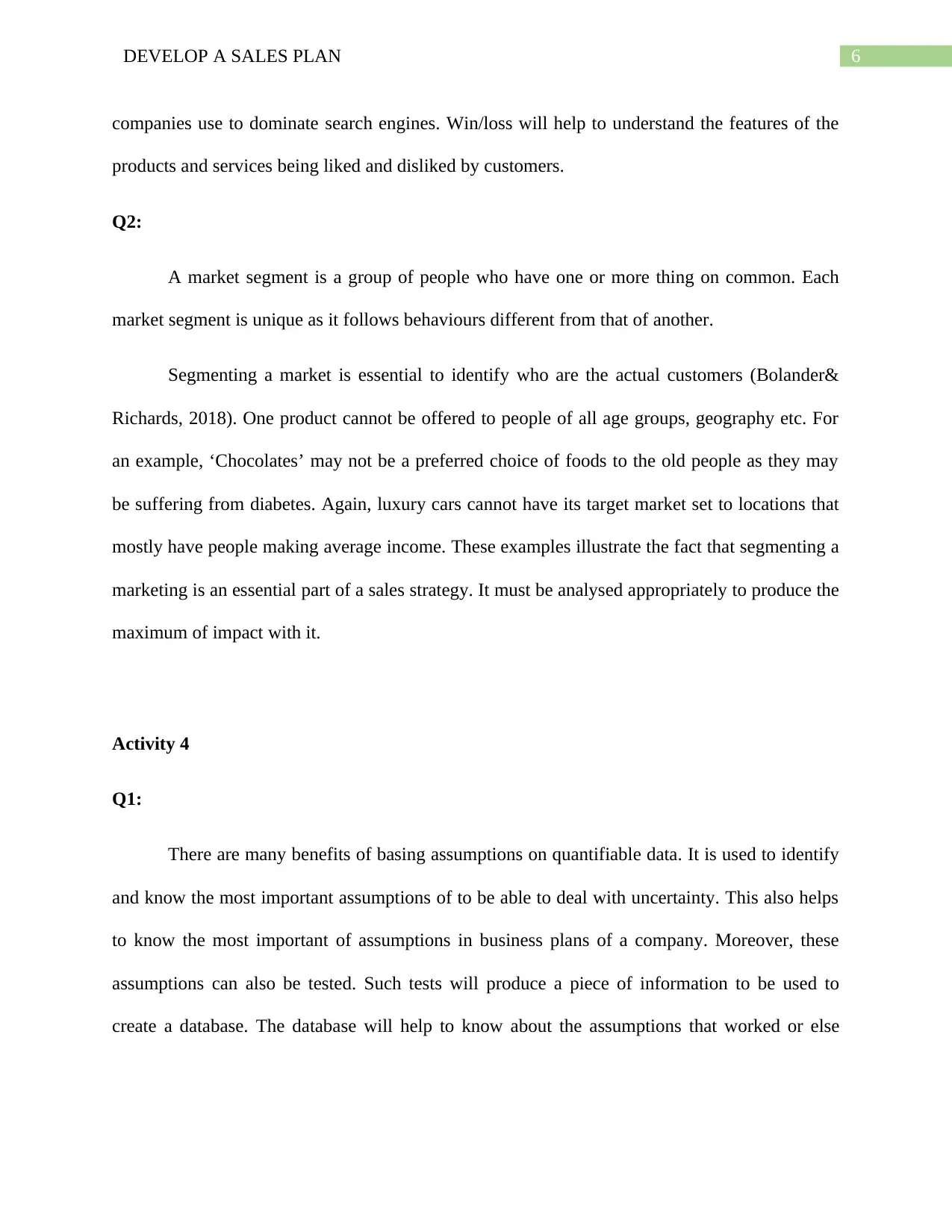
6DEVELOP A SALES PLAN
companies use to dominate search engines. Win/loss will help to understand the features of the
products and services being liked and disliked by customers.
Q2:
A market segment is a group of people who have one or more thing on common. Each
market segment is unique as it follows behaviours different from that of another.
Segmenting a market is essential to identify who are the actual customers (Bolander&
Richards, 2018). One product cannot be offered to people of all age groups, geography etc. For
an example, ‘Chocolates’ may not be a preferred choice of foods to the old people as they may
be suffering from diabetes. Again, luxury cars cannot have its target market set to locations that
mostly have people making average income. These examples illustrate the fact that segmenting a
marketing is an essential part of a sales strategy. It must be analysed appropriately to produce the
maximum of impact with it.
Activity 4
Q1:
There are many benefits of basing assumptions on quantifiable data. It is used to identify
and know the most important assumptions of to be able to deal with uncertainty. This also helps
to know the most important of assumptions in business plans of a company. Moreover, these
assumptions can also be tested. Such tests will produce a piece of information to be used to
create a database. The database will help to know about the assumptions that worked or else
companies use to dominate search engines. Win/loss will help to understand the features of the
products and services being liked and disliked by customers.
Q2:
A market segment is a group of people who have one or more thing on common. Each
market segment is unique as it follows behaviours different from that of another.
Segmenting a market is essential to identify who are the actual customers (Bolander&
Richards, 2018). One product cannot be offered to people of all age groups, geography etc. For
an example, ‘Chocolates’ may not be a preferred choice of foods to the old people as they may
be suffering from diabetes. Again, luxury cars cannot have its target market set to locations that
mostly have people making average income. These examples illustrate the fact that segmenting a
marketing is an essential part of a sales strategy. It must be analysed appropriately to produce the
maximum of impact with it.
Activity 4
Q1:
There are many benefits of basing assumptions on quantifiable data. It is used to identify
and know the most important assumptions of to be able to deal with uncertainty. This also helps
to know the most important of assumptions in business plans of a company. Moreover, these
assumptions can also be tested. Such tests will produce a piece of information to be used to
create a database. The database will help to know about the assumptions that worked or else
Paraphrase This Document
Need a fresh take? Get an instant paraphrase of this document with our AI Paraphraser
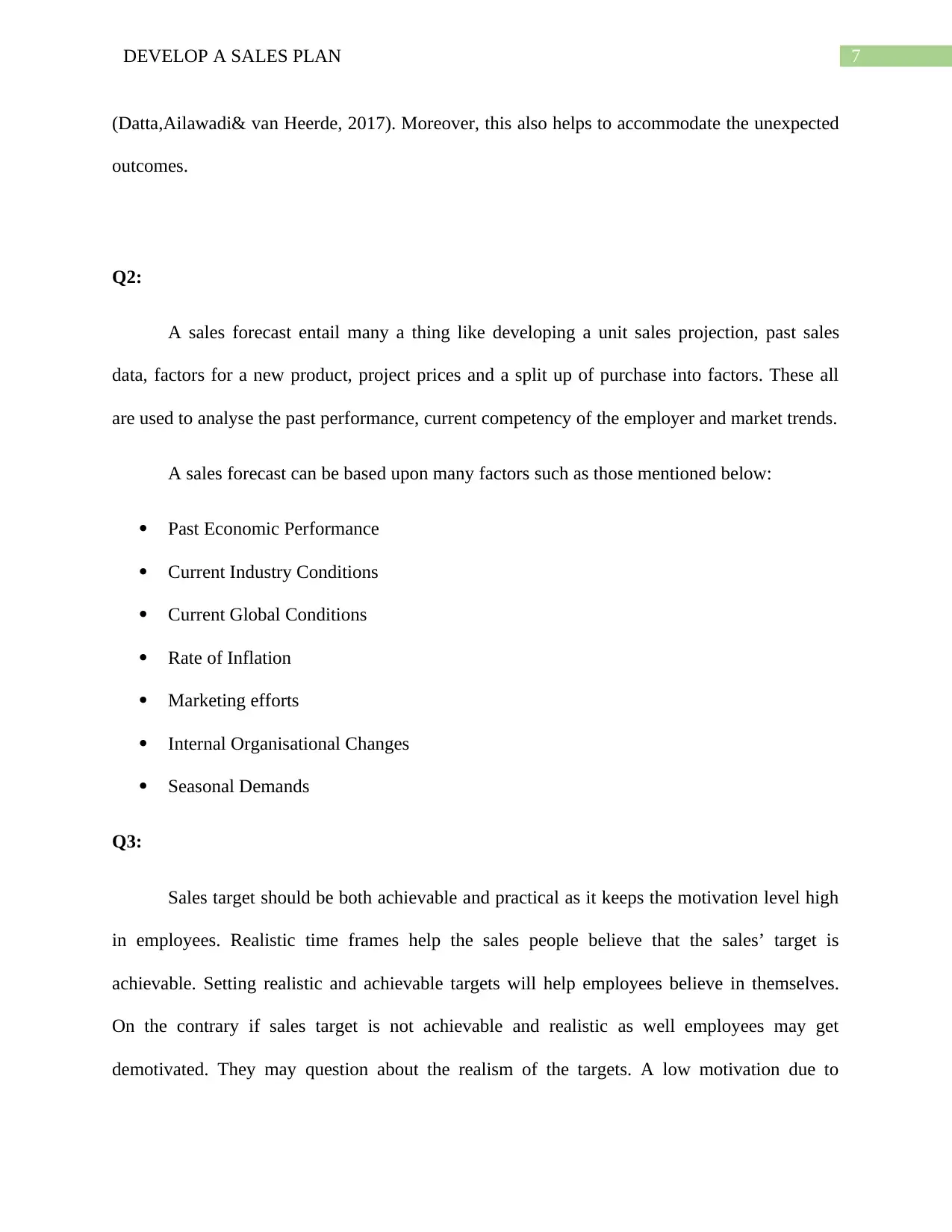
7DEVELOP A SALES PLAN
(Datta,Ailawadi& van Heerde, 2017). Moreover, this also helps to accommodate the unexpected
outcomes.
Q2:
A sales forecast entail many a thing like developing a unit sales projection, past sales
data, factors for a new product, project prices and a split up of purchase into factors. These all
are used to analyse the past performance, current competency of the employer and market trends.
A sales forecast can be based upon many factors such as those mentioned below:
Past Economic Performance
Current Industry Conditions
Current Global Conditions
Rate of Inflation
Marketing efforts
Internal Organisational Changes
Seasonal Demands
Q3:
Sales target should be both achievable and practical as it keeps the motivation level high
in employees. Realistic time frames help the sales people believe that the sales’ target is
achievable. Setting realistic and achievable targets will help employees believe in themselves.
On the contrary if sales target is not achievable and realistic as well employees may get
demotivated. They may question about the realism of the targets. A low motivation due to
(Datta,Ailawadi& van Heerde, 2017). Moreover, this also helps to accommodate the unexpected
outcomes.
Q2:
A sales forecast entail many a thing like developing a unit sales projection, past sales
data, factors for a new product, project prices and a split up of purchase into factors. These all
are used to analyse the past performance, current competency of the employer and market trends.
A sales forecast can be based upon many factors such as those mentioned below:
Past Economic Performance
Current Industry Conditions
Current Global Conditions
Rate of Inflation
Marketing efforts
Internal Organisational Changes
Seasonal Demands
Q3:
Sales target should be both achievable and practical as it keeps the motivation level high
in employees. Realistic time frames help the sales people believe that the sales’ target is
achievable. Setting realistic and achievable targets will help employees believe in themselves.
On the contrary if sales target is not achievable and realistic as well employees may get
demotivated. They may question about the realism of the targets. A low motivation due to
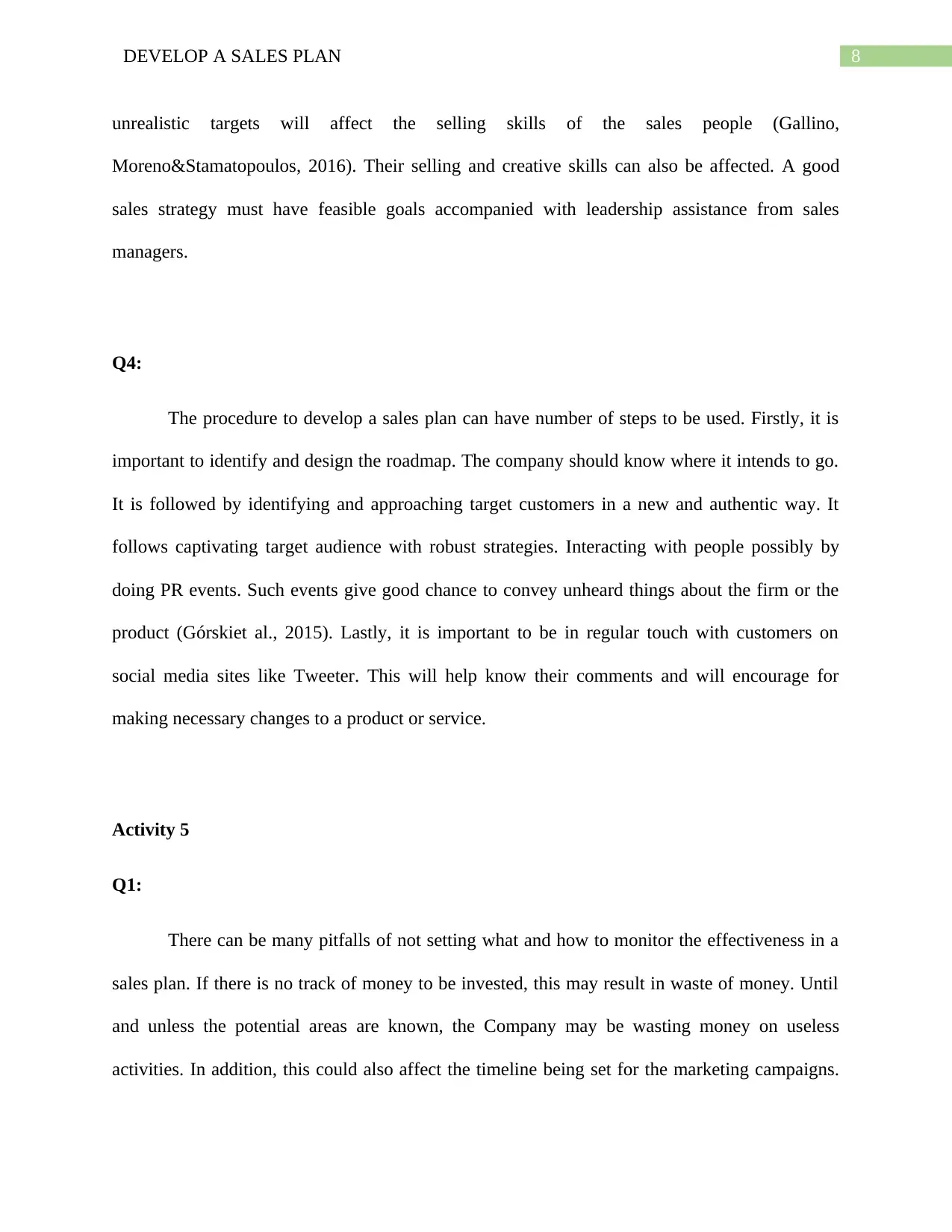
8DEVELOP A SALES PLAN
unrealistic targets will affect the selling skills of the sales people (Gallino,
Moreno&Stamatopoulos, 2016). Their selling and creative skills can also be affected. A good
sales strategy must have feasible goals accompanied with leadership assistance from sales
managers.
Q4:
The procedure to develop a sales plan can have number of steps to be used. Firstly, it is
important to identify and design the roadmap. The company should know where it intends to go.
It is followed by identifying and approaching target customers in a new and authentic way. It
follows captivating target audience with robust strategies. Interacting with people possibly by
doing PR events. Such events give good chance to convey unheard things about the firm or the
product (Górskiet al., 2015). Lastly, it is important to be in regular touch with customers on
social media sites like Tweeter. This will help know their comments and will encourage for
making necessary changes to a product or service.
Activity 5
Q1:
There can be many pitfalls of not setting what and how to monitor the effectiveness in a
sales plan. If there is no track of money to be invested, this may result in waste of money. Until
and unless the potential areas are known, the Company may be wasting money on useless
activities. In addition, this could also affect the timeline being set for the marketing campaigns.
unrealistic targets will affect the selling skills of the sales people (Gallino,
Moreno&Stamatopoulos, 2016). Their selling and creative skills can also be affected. A good
sales strategy must have feasible goals accompanied with leadership assistance from sales
managers.
Q4:
The procedure to develop a sales plan can have number of steps to be used. Firstly, it is
important to identify and design the roadmap. The company should know where it intends to go.
It is followed by identifying and approaching target customers in a new and authentic way. It
follows captivating target audience with robust strategies. Interacting with people possibly by
doing PR events. Such events give good chance to convey unheard things about the firm or the
product (Górskiet al., 2015). Lastly, it is important to be in regular touch with customers on
social media sites like Tweeter. This will help know their comments and will encourage for
making necessary changes to a product or service.
Activity 5
Q1:
There can be many pitfalls of not setting what and how to monitor the effectiveness in a
sales plan. If there is no track of money to be invested, this may result in waste of money. Until
and unless the potential areas are known, the Company may be wasting money on useless
activities. In addition, this could also affect the timeline being set for the marketing campaigns.
⊘ This is a preview!⊘
Do you want full access?
Subscribe today to unlock all pages.

Trusted by 1+ million students worldwide
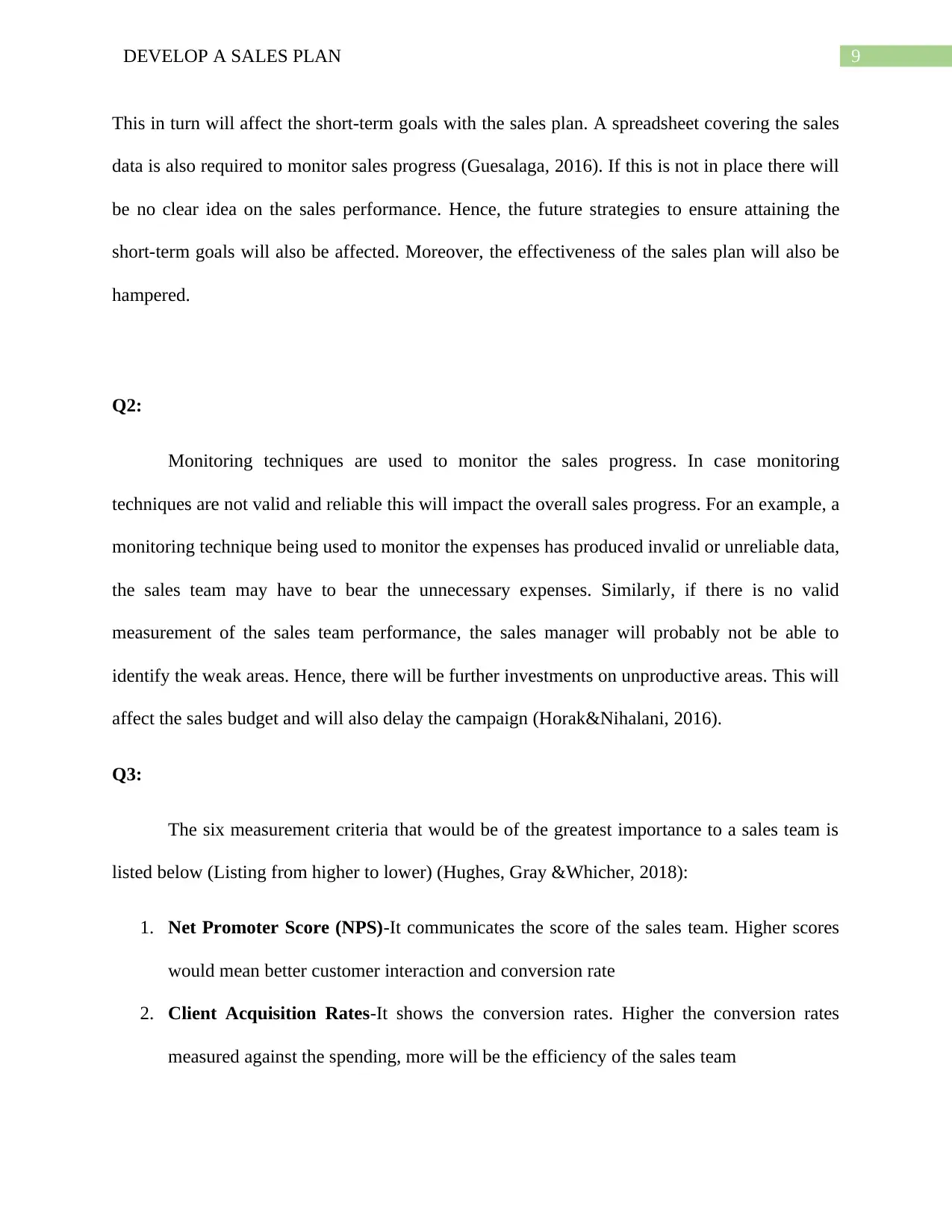
9DEVELOP A SALES PLAN
This in turn will affect the short-term goals with the sales plan. A spreadsheet covering the sales
data is also required to monitor sales progress (Guesalaga, 2016). If this is not in place there will
be no clear idea on the sales performance. Hence, the future strategies to ensure attaining the
short-term goals will also be affected. Moreover, the effectiveness of the sales plan will also be
hampered.
Q2:
Monitoring techniques are used to monitor the sales progress. In case monitoring
techniques are not valid and reliable this will impact the overall sales progress. For an example, a
monitoring technique being used to monitor the expenses has produced invalid or unreliable data,
the sales team may have to bear the unnecessary expenses. Similarly, if there is no valid
measurement of the sales team performance, the sales manager will probably not be able to
identify the weak areas. Hence, there will be further investments on unproductive areas. This will
affect the sales budget and will also delay the campaign (Horak&Nihalani, 2016).
Q3:
The six measurement criteria that would be of the greatest importance to a sales team is
listed below (Listing from higher to lower) (Hughes, Gray &Whicher, 2018):
1. Net Promoter Score (NPS)-It communicates the score of the sales team. Higher scores
would mean better customer interaction and conversion rate
2. Client Acquisition Rates-It shows the conversion rates. Higher the conversion rates
measured against the spending, more will be the efficiency of the sales team
This in turn will affect the short-term goals with the sales plan. A spreadsheet covering the sales
data is also required to monitor sales progress (Guesalaga, 2016). If this is not in place there will
be no clear idea on the sales performance. Hence, the future strategies to ensure attaining the
short-term goals will also be affected. Moreover, the effectiveness of the sales plan will also be
hampered.
Q2:
Monitoring techniques are used to monitor the sales progress. In case monitoring
techniques are not valid and reliable this will impact the overall sales progress. For an example, a
monitoring technique being used to monitor the expenses has produced invalid or unreliable data,
the sales team may have to bear the unnecessary expenses. Similarly, if there is no valid
measurement of the sales team performance, the sales manager will probably not be able to
identify the weak areas. Hence, there will be further investments on unproductive areas. This will
affect the sales budget and will also delay the campaign (Horak&Nihalani, 2016).
Q3:
The six measurement criteria that would be of the greatest importance to a sales team is
listed below (Listing from higher to lower) (Hughes, Gray &Whicher, 2018):
1. Net Promoter Score (NPS)-It communicates the score of the sales team. Higher scores
would mean better customer interaction and conversion rate
2. Client Acquisition Rates-It shows the conversion rates. Higher the conversion rates
measured against the spending, more will be the efficiency of the sales team
Paraphrase This Document
Need a fresh take? Get an instant paraphrase of this document with our AI Paraphraser
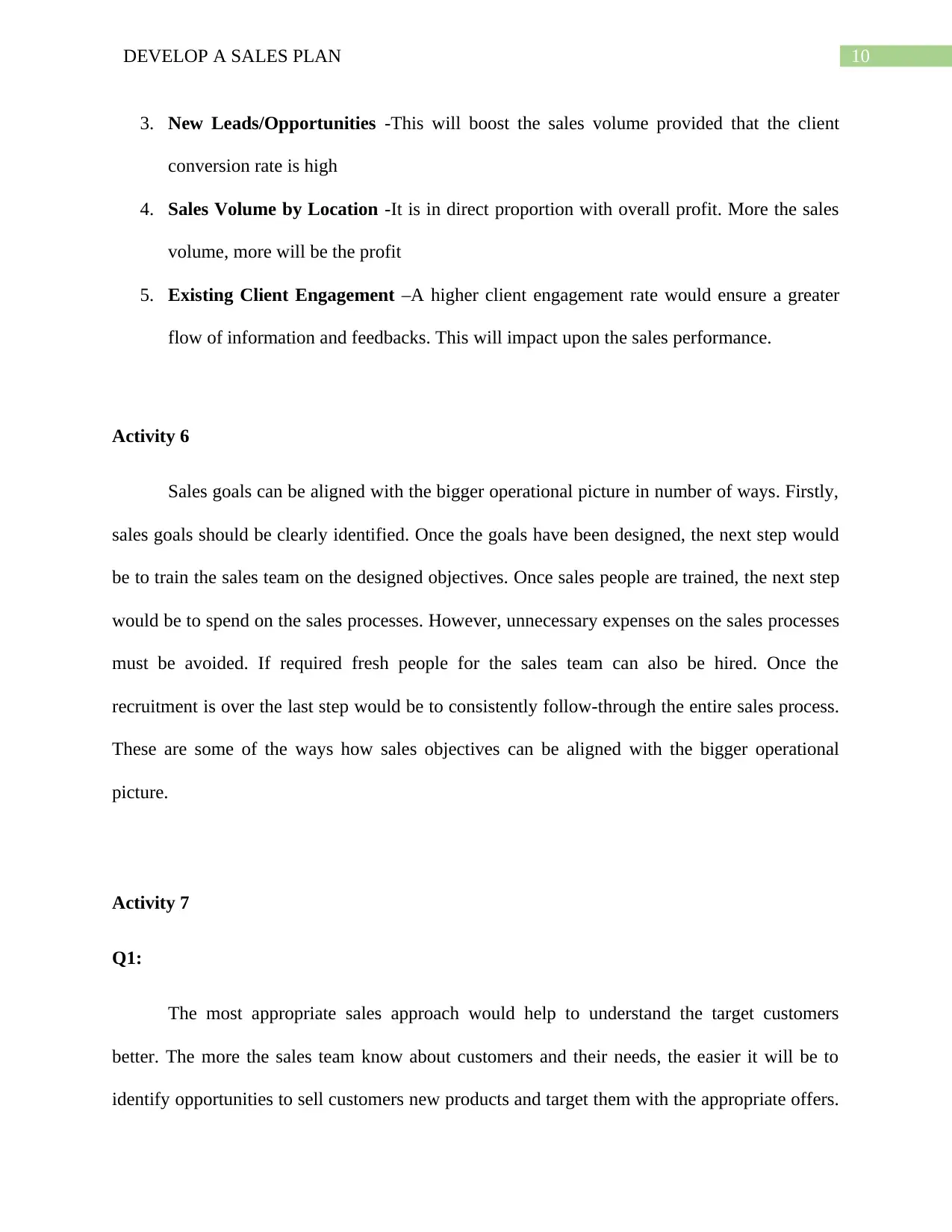
10DEVELOP A SALES PLAN
3. New Leads/Opportunities -This will boost the sales volume provided that the client
conversion rate is high
4. Sales Volume by Location -It is in direct proportion with overall profit. More the sales
volume, more will be the profit
5. Existing Client Engagement –A higher client engagement rate would ensure a greater
flow of information and feedbacks. This will impact upon the sales performance.
Activity 6
Sales goals can be aligned with the bigger operational picture in number of ways. Firstly,
sales goals should be clearly identified. Once the goals have been designed, the next step would
be to train the sales team on the designed objectives. Once sales people are trained, the next step
would be to spend on the sales processes. However, unnecessary expenses on the sales processes
must be avoided. If required fresh people for the sales team can also be hired. Once the
recruitment is over the last step would be to consistently follow-through the entire sales process.
These are some of the ways how sales objectives can be aligned with the bigger operational
picture.
Activity 7
Q1:
The most appropriate sales approach would help to understand the target customers
better. The more the sales team know about customers and their needs, the easier it will be to
identify opportunities to sell customers new products and target them with the appropriate offers.
3. New Leads/Opportunities -This will boost the sales volume provided that the client
conversion rate is high
4. Sales Volume by Location -It is in direct proportion with overall profit. More the sales
volume, more will be the profit
5. Existing Client Engagement –A higher client engagement rate would ensure a greater
flow of information and feedbacks. This will impact upon the sales performance.
Activity 6
Sales goals can be aligned with the bigger operational picture in number of ways. Firstly,
sales goals should be clearly identified. Once the goals have been designed, the next step would
be to train the sales team on the designed objectives. Once sales people are trained, the next step
would be to spend on the sales processes. However, unnecessary expenses on the sales processes
must be avoided. If required fresh people for the sales team can also be hired. Once the
recruitment is over the last step would be to consistently follow-through the entire sales process.
These are some of the ways how sales objectives can be aligned with the bigger operational
picture.
Activity 7
Q1:
The most appropriate sales approach would help to understand the target customers
better. The more the sales team know about customers and their needs, the easier it will be to
identify opportunities to sell customers new products and target them with the appropriate offers.
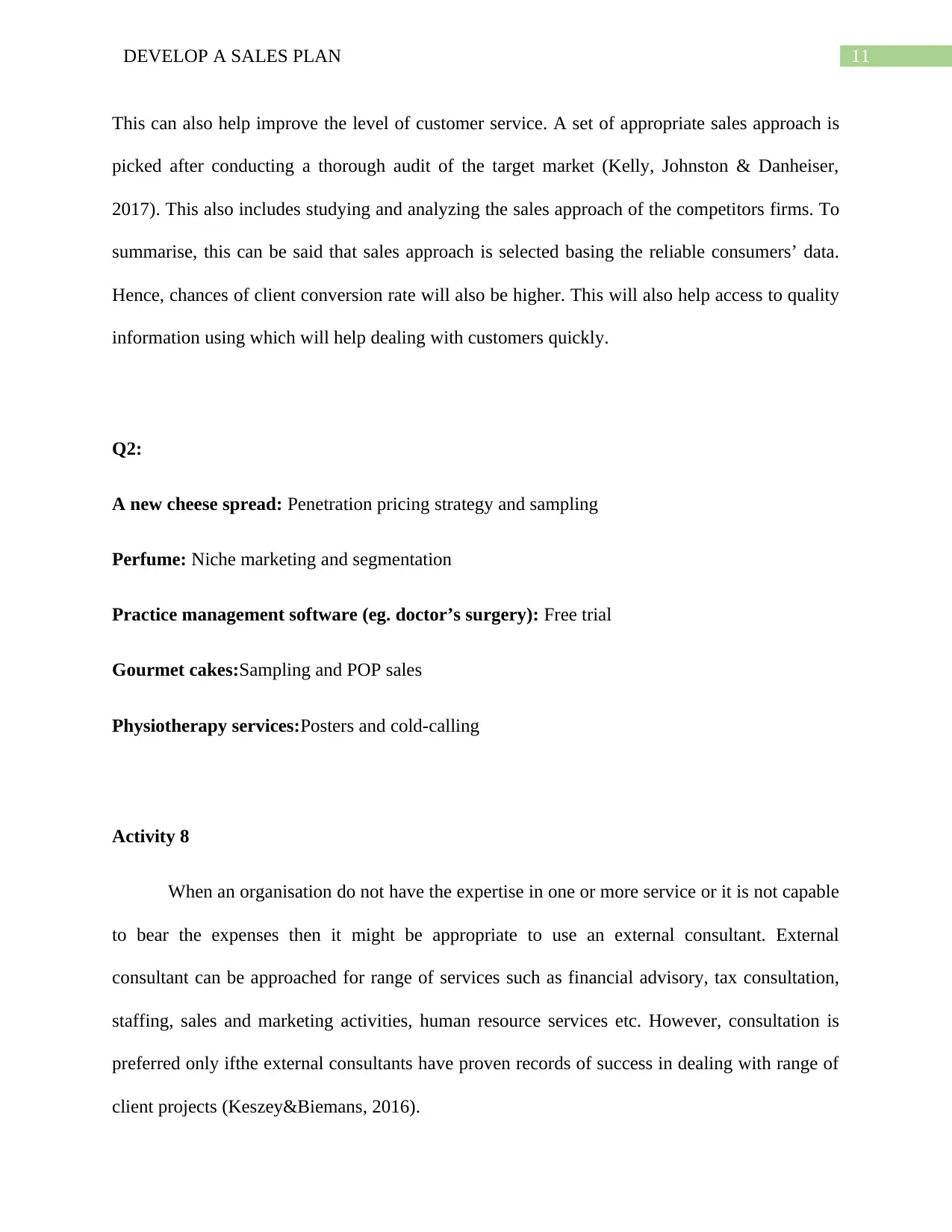
11DEVELOP A SALES PLAN
This can also help improve the level of customer service. A set of appropriate sales approach is
picked after conducting a thorough audit of the target market (Kelly, Johnston & Danheiser,
2017). This also includes studying and analyzing the sales approach of the competitors firms. To
summarise, this can be said that sales approach is selected basing the reliable consumers’ data.
Hence, chances of client conversion rate will also be higher. This will also help access to quality
information using which will help dealing with customers quickly.
Q2:
A new cheese spread: Penetration pricing strategy and sampling
Perfume: Niche marketing and segmentation
Practice management software (eg. doctor’s surgery): Free trial
Gourmet cakes:Sampling and POP sales
Physiotherapy services:Posters and cold-calling
Activity 8
When an organisation do not have the expertise in one or more service or it is not capable
to bear the expenses then it might be appropriate to use an external consultant. External
consultant can be approached for range of services such as financial advisory, tax consultation,
staffing, sales and marketing activities, human resource services etc. However, consultation is
preferred only ifthe external consultants have proven records of success in dealing with range of
client projects (Keszey&Biemans, 2016).
This can also help improve the level of customer service. A set of appropriate sales approach is
picked after conducting a thorough audit of the target market (Kelly, Johnston & Danheiser,
2017). This also includes studying and analyzing the sales approach of the competitors firms. To
summarise, this can be said that sales approach is selected basing the reliable consumers’ data.
Hence, chances of client conversion rate will also be higher. This will also help access to quality
information using which will help dealing with customers quickly.
Q2:
A new cheese spread: Penetration pricing strategy and sampling
Perfume: Niche marketing and segmentation
Practice management software (eg. doctor’s surgery): Free trial
Gourmet cakes:Sampling and POP sales
Physiotherapy services:Posters and cold-calling
Activity 8
When an organisation do not have the expertise in one or more service or it is not capable
to bear the expenses then it might be appropriate to use an external consultant. External
consultant can be approached for range of services such as financial advisory, tax consultation,
staffing, sales and marketing activities, human resource services etc. However, consultation is
preferred only ifthe external consultants have proven records of success in dealing with range of
client projects (Keszey&Biemans, 2016).
⊘ This is a preview!⊘
Do you want full access?
Subscribe today to unlock all pages.

Trusted by 1+ million students worldwide
1 out of 49
Related Documents
Your All-in-One AI-Powered Toolkit for Academic Success.
+13062052269
info@desklib.com
Available 24*7 on WhatsApp / Email
![[object Object]](/_next/static/media/star-bottom.7253800d.svg)
Unlock your academic potential
Copyright © 2020–2025 A2Z Services. All Rights Reserved. Developed and managed by ZUCOL.





